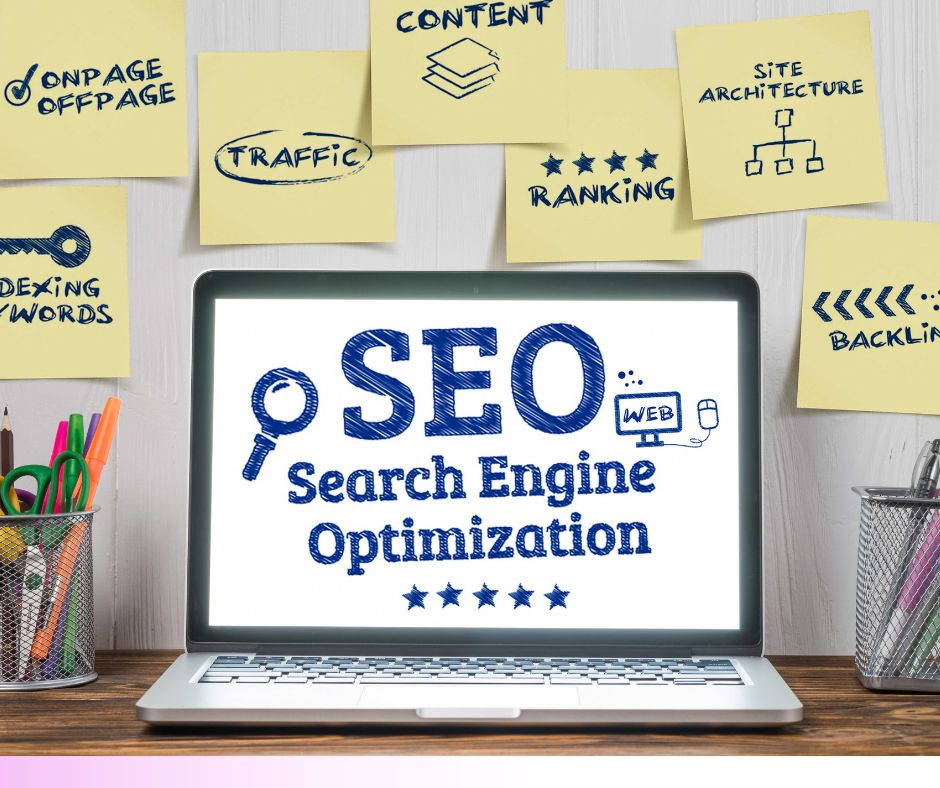In today’s digital age, having an online presence is essential for businesses and individuals alike. But just having a website isn’t enough; you need to ensure that people can find it. That’s where Search Engine Optimization (SEO) comes into play. In this comprehensive guide, we’ll walk you through the fundamentals of SEO, its different facets, and how to optimize your website for better search engine rankings.
Table of Contents
ToggleWhat is SEO?
SEO, which stands for Search Engine Optimization, is a set of strategies, techniques, and best practices used to improve a website’s visibility and ranking on search engines like Google, Bing, and Yahoo. The primary goal of SEO is to make your website more attractive to search engines, increasing the chances of it appearing in prominent positions within search engine results pages (SERPs).
In simpler terms, SEO is all about ensuring that your website shows up when people search for topics, products, or services related to what you offer. It’s a critical aspect of digital marketing because it can lead to increased organic (non-paid) traffic, better user experiences, and ultimately, more conversions and business success.
Why we need SEO?
SEO, or Search Engine Optimization, is crucial in the digital world because it makes websites more visible and trustworthy to users. When a website ranks higher on search engines like Google, it attracts more organic traffic and potential customers. SEO helps build credibility and trust by positioning a website as a reliable source. Moreover, it is cost-effective compared to paid advertising. In a nutshell, SEO is the key to online success by increasing visibility, trustworthiness, and cost-efficiency.
How search engines work?

Search engines work by crawling, indexing, and ranking web pages. They use specialized programs called web crawlers or bots to scan websites and collect information about their content and structure. This data is then indexed, creating a massive database of web pages. When a user enters a search query, the search engine retrieves relevant pages from its index and ranks them based on various factors, including keyword relevance, content quality, and backlinks. The most relevant pages appear at the top of the search results, providing users with the most valuable and accurate information in response to their queries.
Difference between SEO, SMO and SEM
- SEO: The primary purpose of SEO is to improve a website’s organic (non-paid) search engine rankings and visibility to attract more traffic from search engines.
- SMO: SMO aims to enhance a brand’s presence and engagement on social media platforms, fostering a stronger social community and increasing brand awareness.
- SEM: SEM involves paid advertising strategies to gain immediate visibility in search engine results, with the goal of driving traffic and conversions.
| Strategy | Definition | Goal | Examples |
|---|---|---|---|
| SEO | Search Engine Optimization, which is the process of improving the quality and quantity of traffic to a website from search engines. | To rank higher on the search engine results pages (SERPs) for relevant keywords and phrases. | Keyword research, content creation, internal linking, link building, etc. |
| SMO | Social Media Optimization, which is the process of creating and sharing engaging content on social media platforms to increase brand awareness and loyalty. | To reach and connect with the target audience or customers on social media. | Creating and posting videos, images, stories, polls, etc. on Facebook, Instagram, Twitter, etc. |
| SEM | Search Engine Marketing, which is the process of using paid advertising to promote a website on the search engines. | To gain instant exposure and traffic for competitive keywords and phrases. | Creating and running ads on Google Ads, Bing Ads, etc. |
Role of Content in SEO
The role of content in SEO is pivotal. High-quality, relevant, and engaging content is the backbone of a successful SEO strategy. It not only attracts users but also helps search engines understand the purpose and relevance of your web pages. By incorporating carefully chosen keywords and providing valuable information, content optimizes your site for search engine visibility. Moreover, well-crafted content encourages other websites to link to yours, boosting your site’s authority and credibility. In essence, content is the bridge that connects your website to both search engines and your target audience, making it a cornerstone of effective SEO.
SEO Basic
SEO encompasses three core components:
On-Page SEO:
This involves optimizing individual web pages to make them more search engine-friendly. Creating high-quality and engaging content that provides value to users. It includes optimizing title tags, meta descriptions, headers, and content for specific keywords.Off-Page SEO:
Off-Page SEO focuses on activities outside your website to improve its authority. Earning high-quality backlinks from other websites, which signal trust and relevance to search engines. This includes building high-quality backlinks, engaging in guest posting, and promoting your content on other reputable websites.Technical SEO:
Technical SEO deals with the technical aspects of your website. It ensures that search engines can easily crawl and index your site. This includes optimizing site speed, mobile-friendliness, and structured data.
| Category | Definition | Examples |
|---|---|---|
| On-Page SEO | The optimization of the content and elements on a website’s pages, such as titles, headings, meta tags, images, etc. | Keyword research, content creation, internal linking, etc. |
| Off-Page SEO | The optimization of the factors outside of a website that affect its authority and reputation, such as backlinks, social media, reviews, etc. | Link building, social media marketing, influencer marketing, etc. |
| Technical SEO | The optimization of the technical aspects of a website that affect its performance and usability, such as speed, security, crawlability, etc. | Site speed optimization, SSL certificate installation, XML sitemap creation, etc. |
E-EAT
Experience, Expertise, Authoritativeness, and Trustworthiness are four aspects that Google considers when evaluating the quality and credibility of web pages. Here is a brief explanation of each aspect:
- Experience: This refers to the level of knowledge and skills that the author or the website has in their niche or industry. Experience can be demonstrated by credentials, qualifications, awards, achievements, etc.
- Expertise: This refers to the depth and breadth of information and insights that the author or the website provides in their content. Expertise can be demonstrated by originality, accuracy, comprehensiveness, relevance, etc.
- Authoritativeness: This refers to the reputation and recognition that the author or the website has in their niche or industry. Authoritativeness can be demonstrated by reviews, ratings, testimonials, endorsements, citations, etc.
- Trustworthiness: This refers to the reliability and security that the author or the website offers to their users. Trustworthiness can be demonstrated by transparency, honesty, privacy, safety, etc.
These four aspects are collectively known as E-A-T (Expertise, Authoritativeness, and Trustworthiness), and they are one of the ways that Google aims to provide the best and most accurate information to its users.
List of Google Algorithms
Google has developed a series of algorithms to continually refine its search results and deliver the most relevant and high-quality content to users. Some notable Google algorithms include:
Google Panda: Launched in 2011, Panda focuses on content quality. It penalizes low-quality, thin, or duplicated content while rewarding sites with original, valuable content.
Google Penguin: Introduced in 2012, Penguin targets spammy backlinks and manipulative link-building practices. It rewards websites with natural and high-quality backlink profiles.
Google Hummingbird: Released in 2013, Hummingbird aims to understand the context and intent behind user queries better. It facilitates more precise and relevant search results.
Google Pigeon: Introduced in 2014, Pigeon emphasizes local search. It enhances local search results and impacts the ranking of local businesses based on proximity and relevance.
Google Mobile-Friendly Update (Mobilegeddon): Rolled out in 2015, this update prioritizes mobile-friendly websites in mobile search results. It’s crucial as mobile search continues to grow.
Google RankBrain: Launched in 2015, RankBrain is an AI-based algorithm that interprets and learns from search queries to provide more relevant results. It’s a part of Google’s core algorithm.
Google Fred: An unofficial name for updates targeting websites with low-quality content and excessive ads. These updates aim to improve the user experience.
Google BERT (Bidirectional Encoder Representations from Transformers): Introduced in 2019, BERT enhances the understanding of the context of words in search queries. It helps deliver more precise results, especially for longer, conversational queries.
These algorithms and updates are part of Google’s efforts to provide users with the most valuable and accurate information. Website owners and SEO professionals must stay informed about these changes and adapt their strategies to maintain or improve their rankings in search results.
Google Search Console and Google Analytics
Google Search Console (GSC) is a valuable tool that allows website owners to monitor and manage their site’s presence on Google search results. It provides insights into how Google’s search engine interacts with your website, highlighting issues that may affect its visibility. GSC offers data on search performance, indexing status, and crawl errors, enabling you to track your website’s performance and identify areas for improvement. It’s an indispensable resource for optimizing your site’s SEO, ensuring it’s well-represented in Google’s search index, and diagnosing and resolving issues that could hinder your site’s performance.
Google Analytics, on the other hand, is a comprehensive web analytics platform that offers a deep understanding of user behavior on your website. It provides data on website traffic, user demographics, referral sources, and more. With Google Analytics, you can track how users navigate your site, which pages they visit, how long they stay, and whether they complete desired actions (such as making a purchase or filling out a form). This data is invaluable for refining your website and marketing strategies, as it enables you to make informed decisions based on user insights. Google Analytics empowers you to optimize your website’s user experience and drive better results in line with your business objectives.
Understanding User Intent
Understanding user intent is the art of discerning the underlying purpose or motive behind a user’s online search query. It goes beyond the keywords they use and delves into what they truly seek when they type or speak those words into a search engine. By grasping user intent, businesses and website owners can tailor their content and offerings to align precisely with what users are looking for, ultimately enhancing user satisfaction and engagement. This insight allows for the creation of content and experiences that not only provide answers but also guide users toward their desired outcomes, whether it’s seeking information, finding a specific website, or making a purchase, making it a fundamental aspect of effective digital marketing and SEO strategies.
How can optimize content for user intent?
Optimizing content for user intent involves crafting content that directly addresses the specific needs, questions, or goals of your target audience. To do this effectively, start by researching and understanding the various types of user intent—informational, navigational, and transactional—related to your content. Tailor your content to align with these intent categories, using relevant keywords and phrases that users are likely to search for. Provide comprehensive, high-quality information that fulfills user expectations, and ensure your content is structured for easy navigation and readability. Regularly analyze user behavior and feedback to refine your content strategy, ensuring it consistently aligns with and fulfills user intent, thus enhancing user satisfaction and engagement.
SEO Tools
Ahrefs: A comprehensive SEO tool that provides backlink analysis, keyword research, site audit, and competitor analysis features.
SEMrush: Offers keyword research, competitive analysis, site audit, and rank tracking tools, making it versatile for SEO professionals.
Moz Pro: Provides tools for keyword research, on-page optimization, link analysis, and site audits, with a focus on improving website visibility.
Screaming Frog SEO Spider: A website crawler that helps you identify technical SEO issues like broken links, duplicate content, and page titles.
SpyFu: Offers competitor analysis, keyword research, and PPC (Pay-Per-Click) insights to improve both organic and paid search strategies.
Majestic SEO: Specializes in backlink analysis, providing metrics like Trust Flow and Citation Flow to assess link quality.
Real world SEO case studies
Certainly, here are a few real-world case studies that highlight the impact of SEO on websites and businesses:
Moz’s Whiteboard Friday: Moz, a prominent SEO software company, conducted an experiment to optimize their “Whiteboard Friday” video series for search engines. By implementing SEO best practices, optimizing video titles and descriptions, and creating relevant transcripts, they observed a significant increase in organic traffic and video visibility in search results.
Backlinko’s Skyscraper Technique: SEO expert Brian Dean popularized the Skyscraper Technique, where he improved existing content by making it more comprehensive and then actively promoting it to acquire high-quality backlinks. This approach helped him increase organic traffic to his blog by over 110% within two weeks.
HubSpot’s SEO Strategy: HubSpot, a marketing and sales platform, invested in a robust SEO strategy that involved creating a comprehensive knowledge base and blog. They experienced substantial organic traffic growth, with a 100% increase in organic leads within a year.
NerdWallet’s Content Strategy: NerdWallet, a personal finance website, focused on creating high-quality, informative content targeting specific financial topics. This approach led to a 6x increase in organic traffic over two years, demonstrating the power of content-driven SEO.
Conclusion
In conclusion, SEO is a dynamic and multifaceted discipline that plays a pivotal role in the success of websites and businesses in the digital age. By optimizing content, technical aspects, and online presence for user intent, SEO helps improve visibility, credibility, and user experience. Vital tools and case studies underscore its significance, demonstrating its ability to drive organic traffic, enhance online visibility, and contribute to the growth and success of organizations across various industries. Staying updated and implementing effective SEO strategies is essential for any online venture aiming to thrive in today’s competitive digital landscape.






